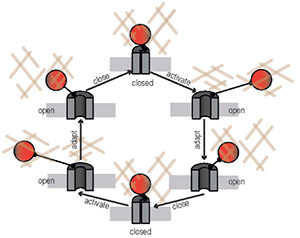Physicists Predict Mechanics of Touch
Published Date
By:
- Susan Brown
Share This:
Article Content

An elastic element opens ion channels in the membrane of a touch-sensitive neuron in response to either a poke or a release, but adapts to steady states by relaxing to close the channels.
A sense of touch mediates much of our interaction with the world beyond our skin.
By turning the mechanical energy of things that impinge on the skin into electrical signals within the nervous system, a variety of structures, or receptors, sense events that range from the faint brush of a breeze to the sharp pain of a cut.
Exactly how they do that isn’t fully worked out. One system in particular intrigued Massimo Vergassola, a physics professor who is part of the Quantitative Biology program at the University of California, San Diego.
At a talk for the QBio program, Miriam Goodman of Stanford University described the responses of a touch-sensitive neuron in the flatworm, C. elegans, a often-used model organism with a well-mapped nervous system.
Poking the worm with a little glass bead generates an electrical current in the touch receptor neuron, which wanes if the bead remains in place. That’s not unusual; it’s a common way for the nervous system to ignore unchanging situations that are unlikely to require our attention. But this touch receptor neuron also generated the same level of current when the bead was removed.
Vergassola, a theoretical physicist with an interest in how organisms use sensory systems to navigate their world, wondered what physical system might underlie the symmetrical neural response. He and graduate student Alessandro Sanzeni developed a physical model that accounted for the observation and predicted additional properties of this sensory system.
“Our equations were able to predict the neural response for the ensemble of stimuli delivered in the experiments,” Vergassola said. Their model includes an elastic element that would stretch to open channels in the nerve cell membrane that allow charge-carrying ions to flow, but then relax to close the channels, even as the receptor continued to be pressed. Release of pressure would again stretch the elastic element, in the opposite direction, re-opening the channels to again allow current to flow.
With colleagues at Stanford University they report their model and experimental results in the Proceedings of the National Academy of Sciences online this week.
The equations also predict that slow pokes wouldn’t register much current, because adaptation—in this case the viscous relaxing of the elastic element—would keep pace with the poke. Experiments found this to be the case, demonstrating that the system acts as a “band-pass filter” by responding preferentially to stimulation that occurs within a particular range of frequencies.
A comparison between eviscerated and normal worms allowed the researchers to discern that the degree of indentation rather than the force of the poke is the key element for provoking a response from this particular type of touch receptor.
The springy element might be remains to be identified, but Vergassola points out that thin, elastic tethers that similarly mediate adaptation to constant stimulation connect bundles of hair cells in the inner ears of mammals.
Co-authors from Stanford University include Amy Eastwood, Bryan Petzold, Sung-Jin Park, Beth Pruitt and Miriam Goodman. Sanzeni is now at the University of Milan. Park is now at Harvard University.
National Institutes of Health and the National Science Foundation supported this work.
Share This:
Stay in the Know
Keep up with all the latest from UC San Diego. Subscribe to the newsletter today.



